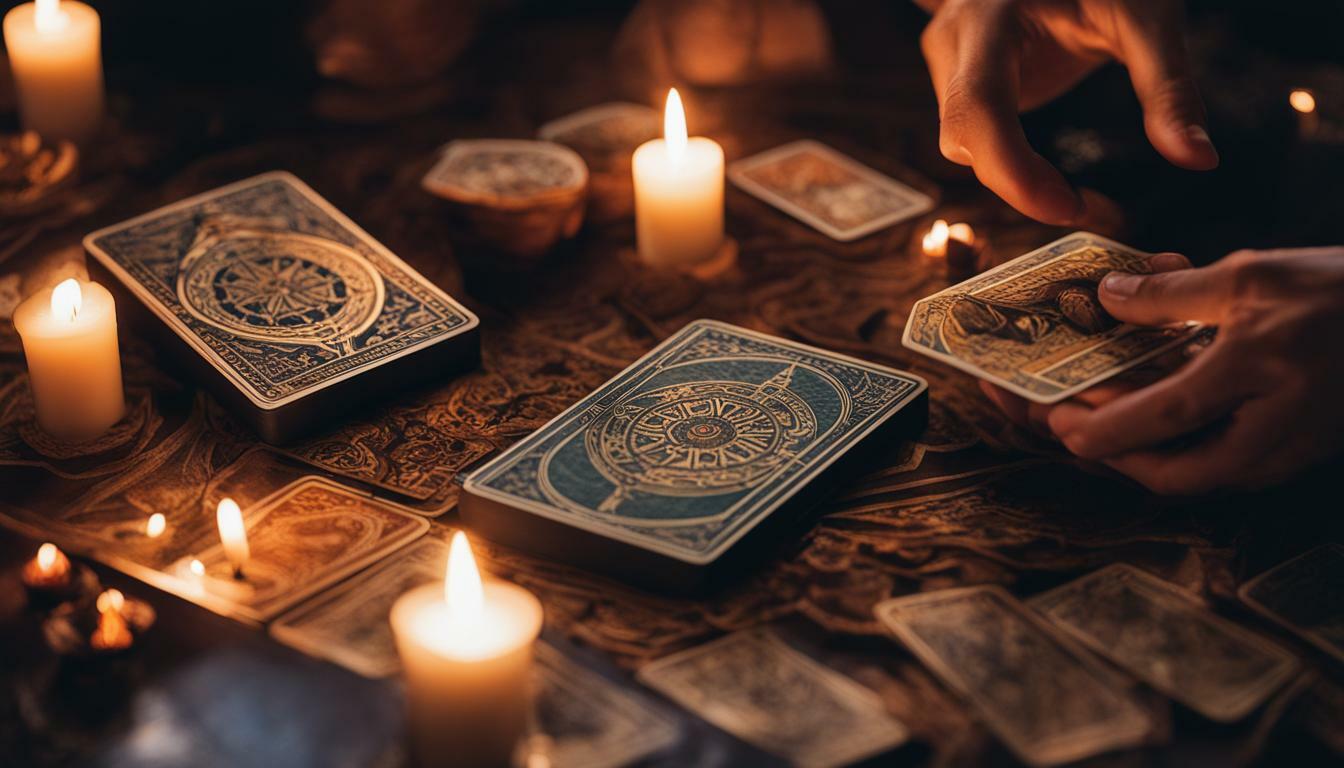Tarot cards have transformed from being associated solely with the occult to becoming a popular tool for self-discovery and personal growth. If you’re a beginner looking to delve into the intriguing world of tarot, this guide will show you how to use tarot cards effectively.
Tarot is not just about fortune-telling; it’s a way to tap into your intuition and gain insights into yourself and your journey. As a beginner, it’s important to start by familiarizing yourself with the meanings of each tarot card. Subscribing to Tarot courses or reading guidebooks can provide valuable knowledge and give you a foundation to build upon.
Once you feel comfortable with the basics, it’s time to choose your own tarot deck. The deck you select should resonate with you and have clear imagery that speaks to your soul. Buying your own deck allows you to establish a personal connection with the cards, making your readings more meaningful.
Caring for your tarot cards is essential for maintaining their energy and accuracy. Establishing a cleansing ritual, such as energetically smudging your deck with sage or palo santo, can help clear any negative or stagnant energy that may have accumulated. Treat your cards with respect and store them in a special place to keep their energy vibrant.
When you’re ready to start your tarot card readings, remember to focus on open-ended questions. These questions encourage deeper insights and allow the cards to provide more meaningful answers. Don’t be afraid to trust your intuition while shuffling the cards and interpreting their messages. Your intuition is a powerful tool that will guide you through your readings.
While it’s important to learn the meanings of each tarot card, don’t be afraid to develop your own interpretations. Tarot is a deeply personal journey, and as you gain experience and practice, you’ll find that the cards speak to you in unique ways. Keeping a tarot journal can help you track your progress and document your evolving interpretations.
Remember that tarot is a lifelong learning process. Consulting other experienced readers and seeking guidance from trusted resources can expand your knowledge and offer new perspectives. Embrace the joy of discovery and allow yourself to be open-minded as you explore the mysteries of tarot.
Key Takeaways:
- Beginners should familiarize themselves with the meanings of each tarot card.
- Choosing a tarot deck that resonates with you is important for a personal connection.
- Caring for your tarot cards involves establishing a cleansing ritual.
- Focus on open-ended questions and trust your intuition during readings.
- Develop your own interpretations and keep a tarot journal to track your progress.
**Exploring Tarot Card Meanings for Beginners**
Before diving into tarot card readings, it’s essential to understand the meanings behind each card. As a beginner, familiarizing yourself with the tarot card meanings will help you interpret the messages you receive. Tarot cards have become more mainstream and are no longer seen as solely for the occult. They are now widely recognized as a tool for self-discovery and personal growth, helping individuals tap into their intuition and receive guidance.
The tarot deck consists of 78 cards, each containing rich symbolism and unique interpretations. To start your journey, consider subscribing to tarot courses that provide comprehensive lessons on the meanings of each card and their different combinations. Online resources, books, and tarot communities can also be excellent sources for learning and expanding your knowledge.
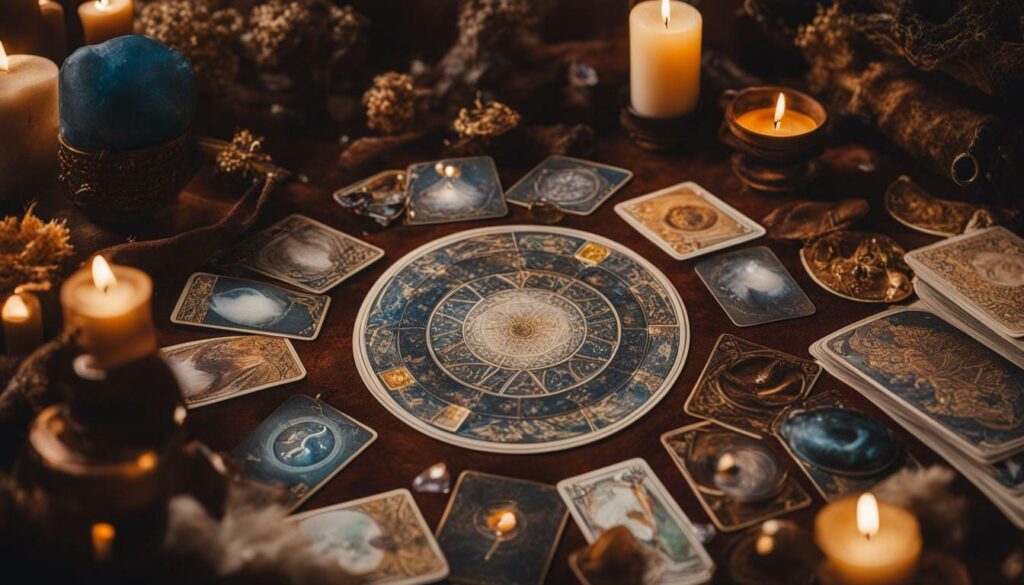
When choosing a deck, it’s important to select one that resonates with you. Look for decks with clear imagery and artistic styles that evoke an emotional connection. Each deck may have slight variations in symbolism or artwork, so finding one that aligns with your personal preferences and intuition will enhance your reading experience.
To care for your tarot cards and maintain their energy, establish a cleansing ritual. You can cleanse your deck by smudging with sage, placing them under a full moon, or using crystals like clear quartz. Regularly consecrating your cards will ensure they remain energetically clear and ready for use.
As you begin your readings, focus on asking open-ended questions that allow for deeper exploration and insight. Trust your intuition when shuffling the cards and pay attention to the images and symbols that resonate with you. It’s essential to keep a tarot journal to record your interpretations and observations. This practice will assist you in developing your own unique understanding of each card and their meanings.
Consulting other experienced readers can also help expand your knowledge and provide different perspectives. Engage in discussions within tarot communities, attend workshops, or seek mentorship from seasoned readers. The insights and guidance from others will enrich your understanding and contribute to your growth as a tarot reader.
In summary, exploring the meanings of tarot cards is a fundamental step for beginners. By familiarizing yourself with each card’s symbolism and interpretations, you will gain a solid foundation for your tarot journey. Remember that tarot is a personal endeavor that requires practice and an open mind. Embrace the experience, trust your intuition, and enjoy the magical journey of tarot card readings.
**Table: Major Arcana Tarot Card Meanings**
| Card Number | Card Name | Keywords | Interpretation |
|————-|———–|———-|—————–|
| 0 | The Fool | Spontaneity, new beginnings, innocence | Represents the start of a transformative journey, urging you to embrace new opportunities and take a leap of faith. |
| I | The Magician | Manifestation, willpower, resourcefulness | Symbolizes the power of your intentions and the ability to manifest your desires. Encourages you to tap into your innate talents and abilities. |
| II | The High Priestess | Intuition, mystery, inner knowing | Represents the deep wisdom within you, urging you to trust your instincts and intuition. Encourages exploration of the subconscious mind. |
| III | The Empress | Nurture, abundance, fertility | Symbolizes the expression of creativity, nurturing energy, and abundance in all aspects of life. Encourages embracing self-care and nurturing relationships. |
| IV | The Emperor | Authority, structure, leadership | Represents stability, structure, and the ability to establish boundaries. Encourages you to take charge and step into leadership positions. |
| V | The Hierophant | Tradition, spirituality, conformity | Symbolizes the pursuit of spiritual knowledge, tradition, and conformity to societal norms. Encourages you to seek guidance from spiritual authorities. |
| VI | The Lovers | Love, partnership, choices | Represents love, harmony, and balanced relationships. Encourages you to make decisions from the heart and embrace the power of love. |
| VII | The Chariot | Willpower, determination, success | Symbolizes overcoming obstacles and achieving victory through determination and willpower. Encourages you to stay focused and motivated. |
**Sources:**
1. Tarot for Beginners: A Guide to Psychic Tarot Reading, Real Tarot Card Meanings, and Simple Tarot Spreads by Lisa Chamberlain.
2. Biddy Tarot website: www.biddytarot.com
3. Labyrinthos Academy website: www.labyrinthos.co
Choosing the Right Tarot Deck
With countless tarot decks available, choosing the right one can be overwhelming for beginners. However, finding a tarot deck that speaks to you and has clear imagery can greatly enhance your experience as you embark on your tarot journey. Tarot cards are not only a tool for self-discovery and personal growth, but they also hold a special energy and connection that is unique to each individual.
When selecting a tarot deck, it is important to consider the imagery and symbolism that resonates with you. Take your time to explore different decks and notice which ones catch your attention or evoke a certain emotion. Trust your intuition and choose a deck that visually speaks to you.
Additionally, it can be helpful to read reviews or seek recommendations from experienced tarot readers. They can provide insights on the artwork, symbolism, and overall energy of different decks. Remember that there is no right or wrong choice when it comes to selecting a tarot deck. What matters most is that you feel a connection and resonance with the cards.
Once you have chosen your tarot deck, it is important to establish a ritual for cleansing and caring for your cards. This can involve smudging with sage, using crystals, or even simply holding the cards in your hands and setting an intention for their use. By taking these steps, you are nurturing a positive energy and relationship with your deck, which will ultimately enhance your readings.
| Benefits of Choosing the Right Tarot Deck |
|---|
| Enhanced intuitive connection |
| Increased personal resonance |
| Heightened visual interpretation |
| Deeper understanding of symbolism |
Remember, choosing the right tarot deck is a personal decision that should be guided by your own preferences and instincts. Don’t be afraid to explore different options and trust your intuition. Your tarot deck should be a reflection of yourself and a tool that speaks to your soul as you embark on your tarot journey.

Caring for Your Tarot Cards
Taking care of your tarot cards is crucial to maintain their energy and accuracy. Establishing a ritual for cleansing and infusing positive energy will help you build a strong connection with your deck. Here are some tips to keep your tarot cards in pristine condition:
- Clearing and Cleansing: Before using your tarot cards, it’s important to clear them of any residual energy. You can do this by smudging them with sage or palo santo, or by placing them in direct sunlight or moonlight for a few hours. This will help reset the energy of the cards and prepare them for your readings.
- Storage: When not in use, store your tarot cards in a protective pouch or box to prevent them from getting damaged or picking up negative energies. Find a special place for them where they can be kept safely and securely.
- Cleansing Ritual: Develop a cleansing ritual that suits your preferences and intentions. You can use crystals, essential oils, or incense to create a sacred space and cleanse your cards. This ritual will not only clear any unwanted energy but also help you connect with your deck on a deeper level.
Remember, your tarot cards are a tool for intuition and guidance, and they absorb the energy of their surroundings. By taking care of them and infusing them with positive energy, you’ll enhance their accuracy and maintain a strong connection with your deck throughout your tarot journey.
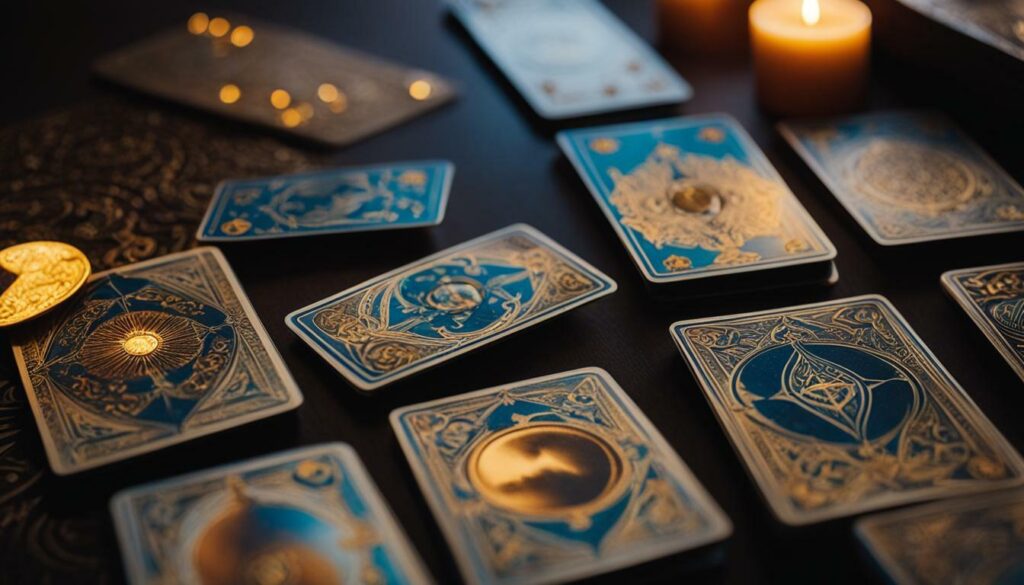
Table: Tarot Card Cleansing Ritual
| Step | Description |
|---|---|
| 1 | Gather your tarot cards and find a quiet space where you can focus. |
| 2 | Light some incense or a smudging tool of your choice, such as sage or palo santo. |
| 3 | Hold your tarot cards in your hands and close your eyes. Take a few deep breaths to center yourself. |
| 4 | Pass each card through the smoke, visualizing any negative energy being released and replaced with pure, positive energy. |
| 5 | Once all the cards have been cleansed, thank the universe, your spirit guides, or any higher power you believe in for their assistance. |
| 6 | Place the cards back in their storage pouch or box, knowing that they are now cleansed and ready for use. |
Starting Your Tarot Card Readings
Now that you have your tarot deck and have familiarized yourself with the card meanings, it’s time to start your tarot card readings. Here’s a step-by-step guide to help you get started.
Step 1: Create a Sacred Space
Before you begin your tarot card reading, it’s important to create a sacred space. Find a quiet and comfortable area where you can relax and focus. You can light a candle, burn some incense, or play soothing music to set the mood. Creating a sacred space helps to center your energy and invite positive vibrations.
Step 2: Shuffle the Cards
Hold your tarot deck in your hands and take a moment to connect with it. Clear your mind and ask a question or set an intention for your reading. Once you feel ready, start shuffling the cards. There are various shuffling techniques, such as the overhand shuffle or the riffle shuffle. Choose the method that feels most comfortable to you.
Step 3: Draw the Cards
When you feel the time is right, stop shuffling and draw the cards for your reading. You can draw a single card for a quick insight or select multiple cards for a more in-depth reading. Trust your intuition and let the cards guide you. Pay attention to any immediate thoughts or feelings that arise as you reveal each card.
Step 4: Interpret the Cards
Once you have drawn the cards, it’s time to interpret their meanings. Refer to your knowledge of the card meanings and symbolism, but also trust your own intuition and personal associations. Consider the imagery, colors, and any intuitive impressions you receive. Every reading is unique, so allow yourself the freedom to interpret the cards in a way that resonates with you.
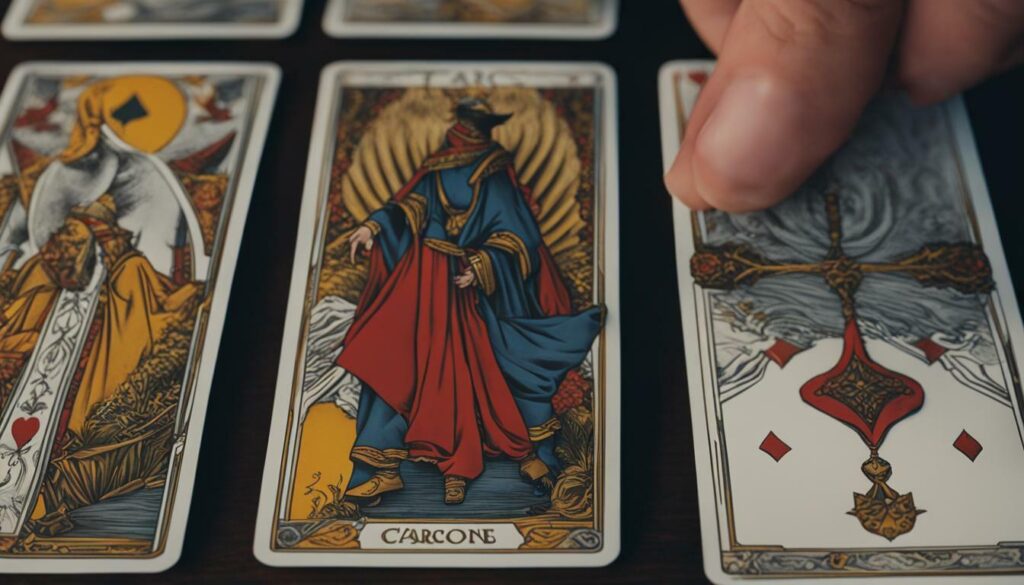
Remember, tarot is a journey of self-discovery and personal growth. Practice regularly, keep an open mind, and trust the process. With time and experience, your tarot card readings will become more insightful and meaningful. Enjoy the journey!
Developing Your Interpretation Skills
While understanding the traditional meanings of each tarot card is important, it’s equally vital to develop your own interpretations. In this section, we’ll explore ways to enhance your interpretation skills as a beginner.
1. Create a Tarot Journal: Keeping a tarot journal is a valuable practice for beginners. Take notes of your readings, record your initial impressions, and reflect on the cards’ symbolism. This allows you to track your progress, observe patterns, and develop your unique understanding of the cards.
2. Experiment with Different Spreads: Spreads are specific layouts used for tarot readings. By trying different spreads, such as the Celtic Cross or the Three-Card Spread, you can gain insights into various aspects of a situation. Experimenting with spreads encourages you to think critically and explore different angles while interpreting the cards.
3. Engage in Group Study: Joining a study group or seeking guidance from experienced tarot readers can greatly expand your knowledge and provide fresh perspectives. Engaging in discussions allows you to learn from others, exchange interpretations, and gain insight into different tarot traditions and practices.
| Tip: | Remember that tarot readings are subjective and intuitive. Trust your intuition and rely on your personal connection with the cards. Your interpretations may differ from others, and that’s perfectly fine. |
|---|
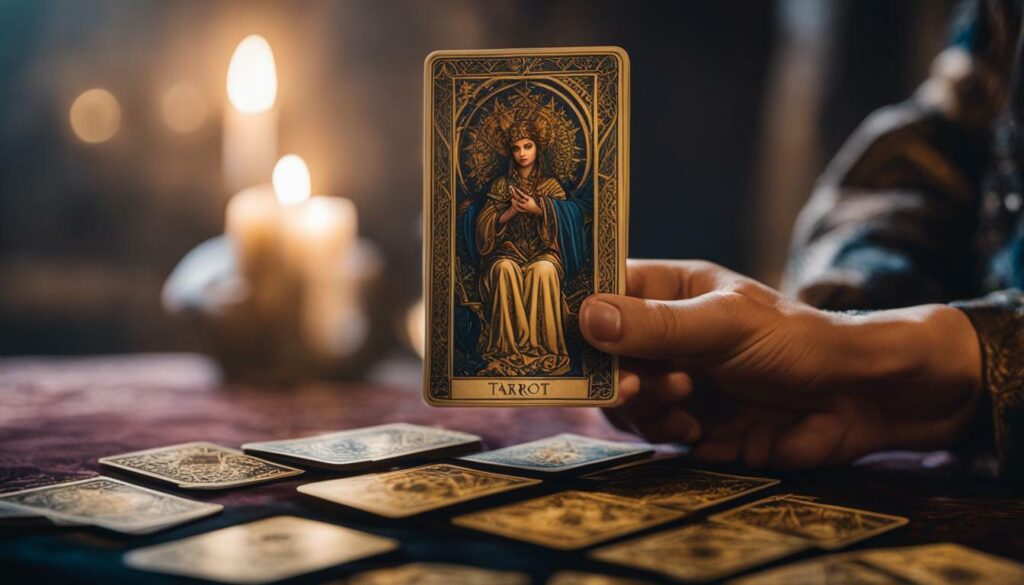
By combining your understanding of traditional meanings with your own unique interpretations, you’ll develop a deep and personal relationship with the tarot. As you continue to practice and explore, your interpretation skills will evolve, becoming more refined and insightful.
Honing your interpretation skills is a journey of self-discovery. Embrace the process, stay curious, and trust your inner wisdom as you explore the fascinating world of tarot.
The Personal Journey of Tarot
Tarot is not just a tool; it’s a personal journey that unfolds as you deepen your practice. As a beginner, it’s important to approach tarot with an open mind and embrace the personal insights it can offer. Tarot cards have evolved from being solely associated with the occult to becoming recognized as a valuable tool for self-discovery and personal growth.
Whether you’re seeking guidance or looking to tap into your intuition, tarot can provide valuable insights into various aspects of your life. Through regular practice and exploration, you’ll begin to uncover the layers of symbolism within each card and develop a personal connection to the archetypes and meanings they represent.
As you embark on your tarot journey, it’s helpful to consult other experienced readers and resources to expand your knowledge and gain new perspectives. Engaging in discussions, attending workshops, and joining online tarot communities can enhance your understanding and enrich your interpretations.
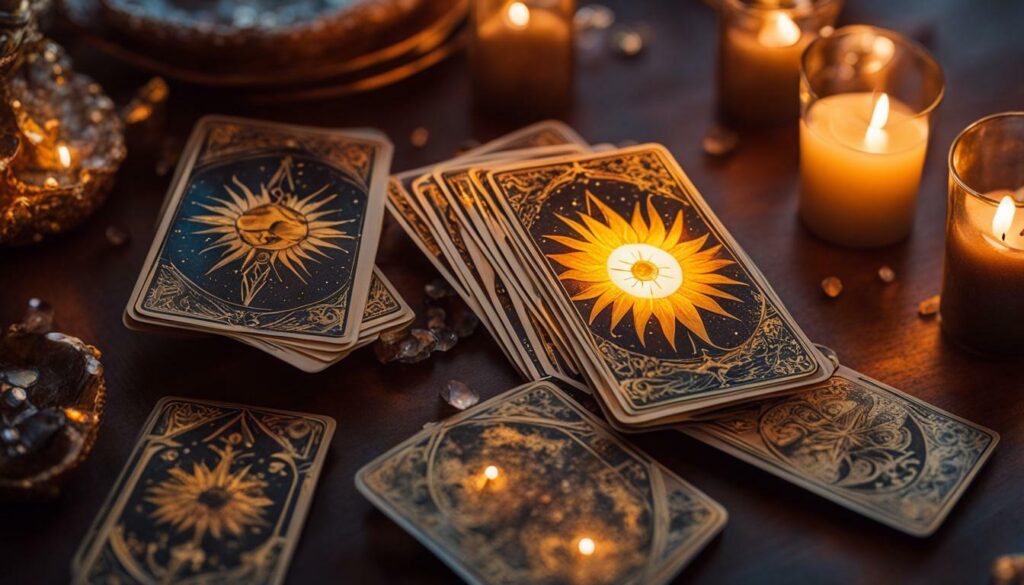
Keeping a tarot journal is a valuable tool for tracking your progress and documenting your insights. Write down your interpretations, observations, and any intuitive messages you receive during your readings. Over time, you’ll be able to reflect on your growth and see patterns emerge, deepening your understanding of the cards and the messages they convey.
Remember, tarot is a personal journey that requires practice, patience, and an open mind. Trust your intuition as you shuffle the cards and ask open-ended questions that allow for a broader and more profound exploration of your situation. As you develop your interpretation skills and establish your unique connection with the cards, you’ll find that tarot becomes a powerful tool for self-reflection, guidance, and empowerment.
| Beginner’s Guide to Tarot Card Readings | Starting Out with Tarot Cards |
|---|---|
| Approach tarot with an open mind | Engage in discussions with experienced readers |
| Embrace the personal insights tarot can offer | Join online tarot communities |
| Develop your interpretation skills | Attend workshops |
| Consult other readers and resources to expand knowledge | Maintain a tarot journal to track progress |
| Trust your intuition during readings |
Consulting Other Readers and Expanding Knowledge
As a beginner, seeking advice and guidance from experienced tarot readers can greatly enhance your understanding and practice. In this section, we’ll explore ways to consult other readers and expand your knowledge.
One effective method is to join online tarot communities and forums, where you can connect with experienced readers and enthusiasts. These platforms provide a wealth of knowledge and insights, allowing you to engage in discussions, ask questions, and receive valuable feedback. Additionally, you can seek recommendations for reputable tarot readers who offer personalized readings or courses tailored for beginners.
Attending workshops and tarot events is another excellent way to expand your knowledge. These gatherings often feature renowned tarot experts who share their wisdom through lectures, demonstrations, and interactive activities. Alongside learning from professionals, you’ll also have the opportunity to connect with fellow beginners and exchange experiences, further enriching your journey into tarot.
Lastly, investing in books and online resources dedicated to tarot can provide you with a comprehensive understanding of different techniques and interpretations. From beginner’s guides to advanced tarot theories, these resources offer a range of perspectives that can help you develop your unique approach to tarot. Remember to explore various authors and their different perspectives to gain a well-rounded understanding.
| Benefits of Consulting Other Readers and Expanding Knowledge | Recommended Resources |
|---|---|
|
|
By consulting other readers and expanding your knowledge, you’ll gain valuable insights, deepen your understanding of tarot cards, and refine your interpretation skills. Remember, tarot is a personal journey, and there is no definitive right or wrong way to approach it. Embrace the diverse perspectives and trust your intuition as you explore the fascinating world of tarot.
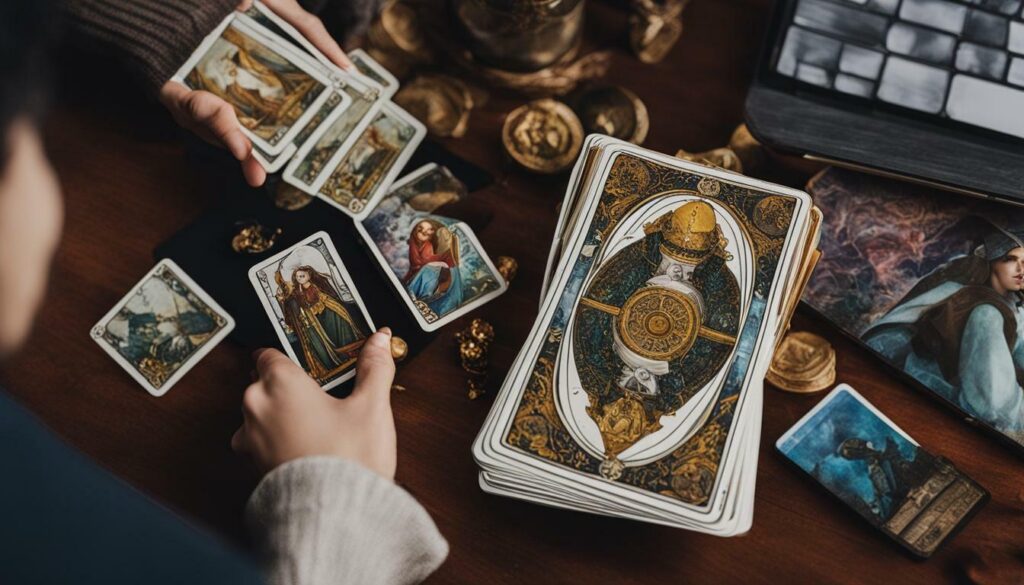
Conclusion
Congratulations on taking your first steps into the fascinating world of tarot! This article has provided you with a comprehensive guide on how beginners can effectively use tarot cards for self-discovery and personal growth. Tarot cards are no longer seen as solely for the occult, but rather as a tool to tap into your intuition and receive guidance.
To get started, consider subscribing to Tarot courses to deepen your knowledge and understanding of the meaning behind each card. Familiarize yourself with the symbolism and interpretations, but also remember to trust your own intuition and develop your own interpretations as you go along.
When choosing your own tarot deck, find one that resonates with you and has clear imagery that speaks to you. It’s important to care for your cards by establishing a ritual for cleansing and maintaining a positive energy. This will not only strengthen your connection with the cards but also ensure accurate readings.
As you begin your tarot card readings, focus on open-ended questions and allow your intuition to guide you. Trust the messages that come through during your readings and don’t be afraid to explore your own unique experiences. Remember, tarot is a personal journey that requires practice, patience, and an open mind.
Consulting other experienced readers and keeping a tarot journal can be helpful in expanding your knowledge and gaining new perspectives on tarot card readings. Learning from others and documenting your own insights will allow you to refine your interpretation skills and deepen your connection with the cards.
So, embrace the magic of tarot, trust yourself, and enjoy the journey ahead. With time and practice, you will unlock the wisdom and guidance that the tarot cards have to offer, and discover the profound impact they can have on your self-discovery and personal growth.
FAQ
Q: How do beginners use tarot cards?
A: Beginners can use tarot cards as a tool for self-discovery and personal growth. By tapping into their intuition, they can receive guidance and insights through tarot readings.
Q: What is the significance of understanding tarot card meanings?
A: Understanding the meanings of each tarot card is important for beginners. It allows them to interpret the cards accurately and gain deeper insights into their readings.
Q: How do I choose the right tarot deck?
A: When choosing a tarot deck, beginners should look for one that resonates with them and has clear imagery. It’s important to select a deck that feels comfortable and aligns with their personal preferences.
Q: How can I care for my tarot cards?
A: To care for your tarot cards, establish a ritual for cleansing and maintaining their positive energy. This can include methods such as smudging or using crystals to clear any negative energy.
Q: How do I start my tarot card readings?
A: To start your tarot card readings, focus on open-ended questions and trust your intuition while shuffling the cards. Allow yourself to be guided by the cards and the messages they reveal.
Q: How can I develop my interpretation skills?
A: As a beginner, it’s important to familiarize yourself with the meanings of each tarot card, but also trust your own interpretations. Consulting other experienced readers and keeping a tarot journal can help you develop your skills.
Q: What is the personal journey of tarot?
A: Tarot is a personal journey that requires practice and an open mind. Each individual’s experience with tarot is unique and should be approached with curiosity and a willingness to explore.
Q: How can I expand my knowledge of tarot card readings?
A: To expand your knowledge, consult other experienced readers, and explore resources such as books, websites, or online courses. This will help you gain new perspectives and deepen your understanding of tarot.
